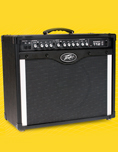Peavey Bandit 112


IT WAS 36 YEARS AGO that the first Peavey Bandit came down the highway, and it has since become a perennial favorite amplifier among a wide range of players. Originally a 50-watt solid-state workhorse, it's now available in a 100-watt incarnation, which we were happy to invite into our studio.
- LOOKS
- Peavey amps have always featured rugged cabinet construction, and the Bandit 112 keeps that tradition going. The speaker panel's brushed aluminum strips and black cowling are securely fastened and rattle-free. The cabinet itself is sturdily constructed of high-density particle board with a 3/8" pine plywood baffle and brawny metal corner protectors. The thick, top-mounted handle has a slightly spongy feel, making it particularly grip-friendly; at just over 40 lbs., the Bandit 112 is well-balanced and easy to carry. Its internal construction looks good, too. The circuit boards and transformer are securely mounted to a folded steel chassis with not a spot of silicone glue. Power- and speaker-related wires are hefty, and what's not part of a ribbon connection is either short or securely bundled. Although the pots and jacks are mounted directly to the circuit board, there's no play between them at all, ensuring a long life.
LAYOUTEach of the 112's two channels—Clean and Lead—has its own tone section with low, mid, and high knobs. There's also a three-position EQ/gain voicing switch for each channel, an improvement on earlier versions of the Bandit, which had two-position switches for each channel. The clean channel is governed by a single volume knob, while the lead channel has pre and post gain controls. The master section at the right end of the front panel has two controls, one for the digital reverb and one for a gain boost new to this version of the Bandit. New features on the back panel include a speaker-emulating direct output and a three-position damping control, first used on Peavey's 5150 amp (now the 6505).
SOUNDThe clean channel can go from Vintage (a bright, black-panel tone) to Classic (a British accent with more pronounced mids) to Warm (a sweaty tweed aroma in the lows, and one of many tonal upgrades on this new model). The lead channel morphs from Classic ('70s-era rock) to Modern (higher gain and scooped mids) to High Gain (much like the Modern setting with the mids restored). Every one of these voicings sounded authoritative and authentic, keeping their identities whether being driven by a single-coil or a humbucking guitar. The tone controls proved smooth and effective with every voicing and the reverb shone throughout its entire range, from "just a hint of hall" to "clouds of angelic mystery." The boost control (up to 10 dB) always delivered as promised without pushing the amp past its limits. The back-panel damping control, designed to tighten bass response at lower volume while opening it up at higher settings, worked like a charm. The additional 4-ohm speaker output also made good on its promise of upping the amp's output from 80 watts to 100, while the three-position power output switch (25%-50%-100%) maintained the amp's personality at every setting. Our only complaint was a mild chassis rattle at the amp's highest settings.
IS IT FOR YOU?The Peavey Bandit is an established benchmark of solid-state amplifi cation. Anyone in need of its reliability and portability will be all the more impressed with the range of tones and upgrades in this newest edition. And at less than $500 list, this Bandit is a steal.
Get The Pick Newsletter
All the latest guitar news, interviews, lessons, reviews, deals and more, direct to your inbox!
“If you’ve ever wondered what unobtanium looks like in amp form, this is it”: Played and revered by Stevie Ray Vaughan, Carlos Santana, and John Mayer, Dumble amps have an almost mythical reputation. But what's all the fuss really about?
“For the price, it’s pretty much unbeatable”: Harley Benton JAMster Guitar review


![[from left] George Harrison with his Gretsch Country Gentleman, Norman Harris of Norman's Rare Guitars holds a gold-top Les Paul, John Fogerty with his legendary 1969 Rickenbacker](https://cdn.mos.cms.futurecdn.net/TuH3nuhn9etqjdn5sy4ntW.jpg)







